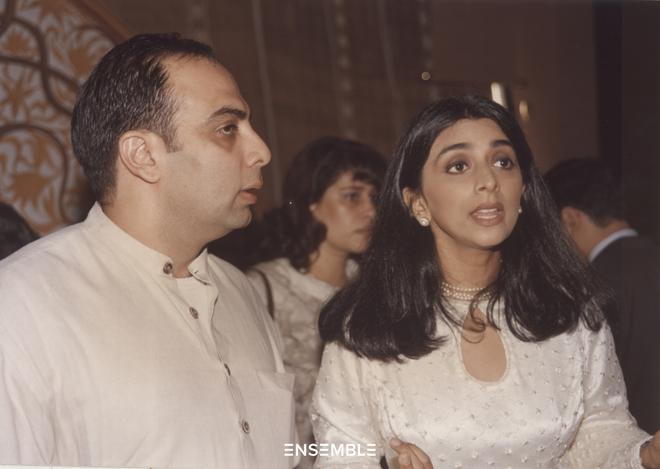As Ensemble completes 35 years, Tina Tahiliani Parikh shares her rulebook on surviving fashion retail in India
As Ensemble completes 35 years, Tina Tahiliani Parikh shares her rulebook on surviving fashion retail in India
For 35 years now, Tina Tahiliani Parikh has been identifying and mentoring new talent, curating collections and ensuring Ensemble stays ahead of the curve. Over the past few years, in particular, it has seen her brave the pandemic by taking on online luxury retail, flirting with social media, and discovering new designers. Some of the country’s biggest fashion names started their fashion journey with Ensemble, but she discounts the myth as one that it takes one Fashion Week designer to create.
“Honestly, we aim to find and promote new design talent and I am proud to say that 80% of the designers from India were launched in our Kala Ghoda store. Before Fashion Week, we used to go out and look for new talent on our own. Of course, Fashion Week made things easier. But I find it more exciting to find talent who do not have the bandwidth to come to such an event,” quipped Parikh, who is in his 50s.
“I clearly remember my first look of Tina. I was straight out of college and working with Tarun. Dressed in a crisp white button-down shirt with high-waisted pants and stunning high heels, she came across as an incredible force of energy. This is the memory I will always have.”Amit Agarwal
In fact, many of his recent discoveries – be it Kshitij Jalori or Karan Taurani – were identified as such. “They never went to fashion week and we found them. Part of our job is to keep exploring and we work with designers in Pakistan, Sri Lanka and Bangladesh as well,” she adds.
Search Instagram: With Instagram and designers unveiling their lookbooks, it’s so easy to launch your own. “Often the pictures are deceptive. We certainly seek an original approach and are constantly being approached by designers who have worked with established names. We understand that his debut collection is likely to be influenced by who he has worked with, but we keep a very strong eye. We look for fit, quality and finish.
From the Ensemble Archives | photo credit: special arrangement
Many things look beautiful on hangers, but they do not fit properly on the body. The interesting thing is that it is very easy to become a designer in India today but the real challenge is to sustain yourself. To be honest, you can have four tailors in your garage in Delhi and become a designer. We look for people who have a thumbs-up about their brand, but are able to move forward and innovate, and who are committed and consistent. It’s a tough industry,” she notes.
Fighting Plagiarism: “There’s been a time or two when a designer has approached me saying, ‘I saw this garment on your Instagram and this aspect of this garment looks like me’ and I always talk to the designer And I work. This,” she says.
“Tina is to me the first lady of fashion. Thanks to her and the ensemble cast, the designers had a place to start showcasing their works. She helps us grow our business better and even feeds us her delicious homemade Gujarati food.”Payal Singhli
Over the years, there have been instances when designers have called them out on plagiarism issues. “Who owns what? That’s a big question. When we started, one of our designers said, ‘Nobody can’ steal ‘Sleeves’, every man or woman wears if we look at Mughal history steal sleeve. A can of worms you opened. It’s a fine line we walk. We are very aware of this.”
Two types of buyers: However, does a buyer care whether it is a copy or not when making a purchase? “There are customers and there are customers – some are very committed to design. A vast majority cannot care and are interested in purchasing a dress and are budget conscious and now with Instagram, they want the apparel to go well.” Get photographed,” she says.

From Ensemble Archives – Tina Tahiliani Parikh with her brother Tarun Tahiliani | photo credit: special arrangement
During the lockdown, there was a huge demand for brides with 50 guest weddings. Too many classics, fabric-turned-pieces became a rage. Overall, we figured out ways to navigate the uncertainty so that it was fair to everyone.
“She has pieces from 15 to 20 years old in her wardrobe. She takes so much care of her vintage clothes. She is not only a savvy shopper but also a true champion of sustainability. Besides, whether a designer can make a simple white shirt is his litmus test.”Amit Hansraj
Proposal of ‘Revier’: “The important thing is that people are becoming aware that fashion is the second most polluting industry in the world. However, there is no measure to measure which brands are truly sustainable in India. One of the best ways to be sustainable is to encourage your customers to re-wear your clothes. In one of our initiatives – Rewear – we encourage our customers to come to us with old pieces and we show them how to mix and match and re-wear it multiple times. That’s what I live by and wear my clothes until they tear.”
Consignment Management: A lot of designers had a problem with general consignment rules when their collections were left unsold and damaged during the pandemic. One wonders if the rules have changed? “During the pandemic, in many cases, we had supported designers to try and build this. If they had any progress we had, we would let them be. Many of our designers changed on an order basis because there was a large amount of uncertainty and many designers lost their workforce [who had gone home during the lockdowns],